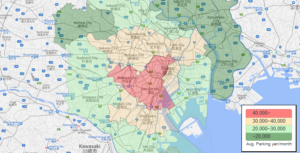To own, rent or share a car in Japan as a foreigner: A practical guide to navigate car usage
When you are searching for accommodation in Japan as a foreigner, please do not overlook the close connection between the selection of your new home and your individual mobility choice: In case you would like to buy and own a car, whether used or new, you need a space to park it because, different from many countries, free-float parking is illegal in Japan.
As a result, when dealing with your housing agent, you better always inquire about parking opportunities at or near your prospective accommodation, whether an apartment or a house, if you consider owning a car soon or later. This important point leads us to the question of what is better in Japan – buying or renting a car? With this article, we would like to help you to make this difficult choice by pointing out the most relevant options and their costs.
In general, if you choose to live close to or in the center of huge cities like Tokyo or Osaka, you will most likely use public transport to commute to work, go shopping and meet friends. The simple reason is that these cities have an excellent public transportation system with high-frequency trains, subways, and buses, that can take you almost anywhere you need to go. The public transportation system in Japanese metropolitan areas is unbelievably efficient, reliable, affordable, and safe. About one third of all personal transport in Japan happens on rails – this is almost four times the share in large countries like Germany.
Parking space, employer rules as challenges
The main difference between using public transport or your car, besides the initial purchase price and the running expenses of an automobile, is the relatively high cost of parking in Japanese cities due to the scarcity of space. Renting a parking lot can set you easily back by 20,000 to 50,000 yen a month in the central districts of Osaka, Nagoya, or Tokyo.

Average parking prices in the central districts of Tokyo exceed 40.000yen per month, which includes tower parking spots as well. It is not uncommon to pay upwards of 400USD per month for a standard parking spot. (Data analyzed by apts.jp)
However, if you succeed in renting a comparatively inexpensive parking space, or rent a full house that almost always has an integrated parking space, a car could be a convenient alternative to being stuffed into often crowded commuter trains. Some people simply prefer the convenience and comfort of owning a car.
One further piece of advice, though: If you would like to commute to work daily, make sure your employer offers employees parking lots. Many don’t. If your company does, there might be a waitlist. Another caveat: Most employers reimburse their employees for commuting expenses, but only if they use public transportation! However, this policy may be negotiable.
A final point to consider when choosing your mobility is your level of Japanese. With a limited language capability, it is certainly easier to just use public transport than buy or rent an automobile because of the complicated processes involved. At the same time, there will always be a helpful Japanese colleague or friend to support you in mastering such challenges.
Good arguments to own a car if you live outside of big cities
There are more reasons to own a car in Japan: Weekly shopping and luggage transports are easier done. Families with young children may find it more practical to own a car, especially to transport the kids to and from school, doctor’s appointments, or other activities.
Also, if you prefer to live in the suburbs or the countryside, it might be more convenient to buy a car for personal use. The public transportation networks are not very dense outside of the metropolitan areas, with no train station or bus stop nearby and bad connections. In such areas, there are also few opportunities to rent a car or call a taxi. Hence, the natural choice would be to buy a car to become mobile.
How much do you have to pay for a car in Japan?
The actual cost of buying a new car in Japan depends on many factors. There is the initial purchase price (starting from around 1 million yen), an acquisition tax (several 10,000 yen), and a weight tax (starting from 10,000 yen). Besides, you have to pay recurring costs like mandatory liability insurance (20,000-30,000 yen per year), automobile tax (regular cars: 30,000-50,000 yen; “kei” or “light” cars: 5,000-20,000 yen per year), and optional insurance (40,000-70,000 yen per year depending on size, model, age, etc.).
A final word about a special challenge for foreigners: Many brands and dealers offer to pay for a new (or used) car in monthly installments with very low interest rates or an attractive leasing contract where you have to pay less cash upfront. However, depending on the type of visa and residence status, many banks are reluctant to allow foreigners to sign such credit agreements. Better be prepared to pay the full sum.
How to choose and find an affordable car in Japan
But before you go shopping for a model that fits your needs, there are some very simple and easy truths you should know in advance.
First, the value of a new car in Japan drops immediately after the purchase. One reason is that Japanese buyers prefer new to used cars and like to be the first owner. The average sales price of a used car in Japan is about 1.5 million yen (Source).
The price drop is often attributed to the biannual compulsory regular vehicle inspection (shaken). Its cost tends to increase with the age of a used car because if your shaken garage finds failing or faulty parts and functions, they have to be repaired or you cannot use the car anymore. The fee for the actual shaken examination varies usually in the range of 70,000 to 150,000 yen and does not include the repair costs.
Why every third car sold in Japan is a kei car
Second, there are two types of cars in Japan – regular and “kei” (light). The latter are recognizable by their yellow license plate, small size, often funny design, and their low prices starting from around 1 million yen. Taxes are also lower. The price of the bestselling “Honda NBox”, a better-equipped kei car often driven by housewives, starts from about 1.5 million yen. These features explain that every third car sold in Japan is a kei car.
Besides, they are cheaper to run due to their small and fuel-efficient engine with many models capable of achieving over 30 kilometers per liter. Their small size makes them ideal for navigating crowded urban streets and tight parking spaces. But they are not convenient for longer trips due to weak engine power and thinner isolation. Some models have been criticized for their safety features, which may not be as robust as those found in larger cars.
Why you need a fatter wallet for foreign cars in Japan
Third, foreign models are comparatively expensive because they often cost more in their origin countries compared to models of Japanese makers in their home country, partly due to the unfavorable currency conversion and different general price levels, with the shipping to Japan pushing the price further up.
From anecdotal evidence, one may also conclude that the spare parts for foreign models in Japan are a) generally much more expensive compared to Japanese models and b) often take weeks or months to arrive from abroad because the dealers have only a limited stock.
Car on subscription, peer-to-peer car sharing have arrived
Fourth, a modern form of ownership has come to Japan – the “car on subscription”. Under the name “Kinto“, Toyota launched 2019 the offer to rent cars for a monthly all-inclusive fee. The subscriptions run for three, five, or seven years, and you can change cars at any time. There are dozens of models to choose from. Nissan, Honda, and the Gulliver dealer chain are now also selling many of their models via monthly all-inclusive rental contracts.
Fifth, another modern option for car owners is peer-to-peer car sharing: The C2C car-sharing service Anyca, launched in February 2019, allows private individuals to rent their cars to other people via a platform. The service has 20,000 cars and 500,000 users (as of June 2021). Anyca has the backing of industry giants DeNA (internet) and Sompo (property insurance).
Renting a car recently has become expensive
The alternative to permanent ownership is renting or sharing a car just for the time you need it. Obviously, you do not have to worry about depreciation, recurring costs, maintenance, and parking which makes renting quite attractive. Also popular is a “combination option” to own a cheap city car and to take trains for long distances and rent a car at your exit train station.
For a rental, you will need a Japanese driver’s license. Foreigners may drive with an International Driving Permit (IDP), but only for the first year of their stay. (Drivers from Germany, Switzerland, France, Belgium, and Taiwan need an official Japanese translation of their national driver permits, also only for the first year.) After one year, you need a Japanese license. For citizens of most countries, this requires no new driving test.
The leading rental companies are Toyota Rentacar (in English), Nippon Rentacar (in English), Orix Rentacar (in English), Times Car Rental (in English), Nissan Rentacar (in English), and Ekiren for renting a car at a train station (in English). You can book a car through international brands like Avis, Budget, or Hertz, but they use the major Japanese car rental companies as a partner and may charge higher fees than if you book directly.
Typical rental rates vary widely due to size, season, and location and have gone up recently. For a compact mini-vehicle like Nissan March, expect to pay around 7,000 yen for half a day and 9,000 yen for a full day. A full-size car like Toyota Corolla for a full day costs about 18,000 yen (prices in early March 2023). Rates usually include unlimited mileage, taxes, and a minimum insurance fee. International credit cards are accepted for payment.
What is behind the amazing boom of car sharing in Japan?
Alternatively, consider renting a sharing car, i.e. a rental car with app booking. Since 2013, this market has been growing rapidly: As of March 2022, about 52,000 sharing cars were used by about 2.5 million users annually. However, providers have to use fixed pick-up stations because free-float parking is strictly prohibited in Japan.
As a result of this regulation, the market leader is Times Mobility (Brand: Times Car) because its parent company operates most of the rental parking spaces in Japan and reserves some spaces for sharing cars. The four main competitors are Orix Carshare, Careco Carsharing Club, and Toyota Share. Only Times Car offers an English website for sign-up, but all apps are only available in Japanese.
Car-sharing requires a web registration with a Japanese (!) driver’s license, a credit card, and a smartphone number, often with a set-up fee. There are free and paid monthly plans. Charges are based on units of 15 minutes, with fees between about 200 and 500 yen. The rates are also applied to packages of up to 6 hours, 12, or 24 hours. With a paid membership, rates are lower. Gasoline and insurance are usually included in these fees.
To the surprise of the providers, some Japanese are booking sharing cars not for driving, but eating in privacy, watching TV on the car system, storing their shopping bags, charging their smartphones with the car battery, or just taking a short nap. Admire this creativity, please!
